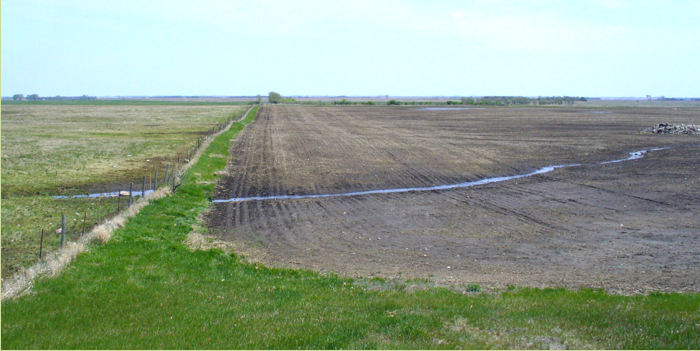Our time on earth is brief, yet the land goes on forever, carrying with it the marks of each succeeding landowner. As fleeting trespassers on land that belongs to future generations, we must touch the land gently, caring for it as true stewards, so that those who assess our record will see our love and respect for the land and life. (Robert G. Oetting)
I find this quote thought-provoking because, regardless of perspective, the author is speaking to every landowner, land manager, land planner or “user” of the land. However, depending on personal values various “users” of land can impact the land much differently. Case in point is the photo above. Obviously, the landowner on the left of the fence sees the benefit of grass, whereas the owner on the right sees the benefit of a commodity crop over the grass, so the grass was plowed under. The landowners hold different values driving these decisions about how to manage their lands.
As conservationists, is it our role to “change” values? I think some respondents would say “yes” while others would say “no.” Perhaps the relevant question to ask is, “what is necessary for long-term sustainability of a landscape and the community it supports?” Is the answer to this question a diversity of agricultural crops that help support the local economy? Or is it healthy soil, clean water and clear air quality for which an economic price is hard to derive? Maybe it’s a certain amount of unplowed grass and un-drained wetlands that provide both economic and social benefits? All considered, it’s most likely a combination of the above. From the perspective of the PPJV, we value intact grasslands and wetlands across the landscape. Even though other users may not hold this same perspective, we respect their values so may they respect ours.
The first article in this edition of the PPJV newsletter speaks to the idea of shared values and a new partnership between the PPJV and the South Dakota Grasslands Coalition. The Coalition is primarily a group of ranchers interested in keeping the ranching community a vibrant and healthy enterprise in South Dakota. To do that, they need grasslands to remain on the landscape. This new partnership resulted in a two-day “Grassland Conservation Tour on Private Lands” in South Dakota in mid-May. This wonderful event was capped by passionate and committed landowners who spoke as part of the tour.
Our next article is a very interesting account of what can happen when a state loses most of their wetlands. With determined partners and unwavering commitment, Iowa has brought back the Trumpeter Swan through reintroductions and steadfast wetland restoration and management.
Then, we highlight a very valuable partner in the Prairie Pothole Region (PPR) – The Nature Conservancy. This non-governmental organization has worked in the PPR for over 50 years. The scope of projects, as reflected in the article, across all of the PPJV states clearly shows the critical impact their efforts have to both conservation and the PPJV partnership.
Finally, this edition of the newsletter concludes with two short articles on PPJV Science activities – one providing an update on our revision of the Implementation Plan, highlighting our concerted effort to engage states and partners to develop “State Tactical Plans” and the other covering a very important development in Montana with regards to our ability to better monitor birds, particularly grassland birds.
Casey Stemler, PPJV Coordinator, casey_stemler@fws.gov

